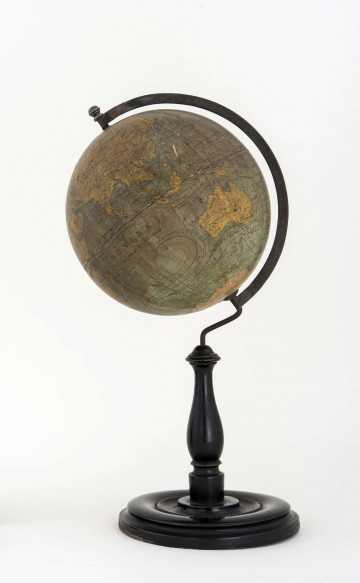
Physical globe of the Earth
1924 — 1931
National Museum in Lublin
Part of the collection: Polish globes of Earth 19th–1st half of the 20th c.
It can be said about every globe that it is a model of our planet diminished in relation to the original usually by several dozen or even several dozen million times. The scale of miniaturisation makes it impossible to mark on it many objects really existing on the Earth's surface – so-called generalisation is necessary (that is generalisation, i.e., giving up some details). However, the richer the map, the more useful and attractive it is, which usually encourages producers to increase its content.
When making all kinds of maps, including globe maps, which are usually two-dimensional and therefore flat, cartographers use many colours, lines and signs. Knowledge of their symbolic meanings allows the users to imagine the character of a given space, its actual content. However, there is always a temptation to make even one more step towards a more literal model.
The globe discussed here is unique, both because of its rarity, the richness of the content presented and the third dimension added to it. It is, if one may say so, a 3D globe, although not in the full scope and meaning of the term, as a different scale has been used for the two dimensions horizontally and for the third one vertically, which is a kind of distortion, although it increases the clarity of the presentation of the relief of the continents. No similar depiction of the shape of the surface of the bottoms of the seas and oceans has been made, as the depths of individual reservoirs have been illustrated only on a bathymetric colour scale.
Another interesting fact is that researchers were able to establish the date of the globe's issue (1924 or earlier) based on an analysis of the advertising materials of the producer – the company Katowicka Dostaży Szkolna ‘Kados’, which operated between 1922 and 1929.
As we read in the documentation, the globe came into the collection of the Wincenty Pola Manor House as a donation from the Primary School in Klemensowo near Szczebrzeszyn in 1983. It was a part of a larger campaign organised at that time. A school that donated an old globe could receive a contemporary one in exchange. In this way, valuable exhibits were added to the museum's collection, while educational institutions gained new teaching aids.
Dimensions
cały obiekt: width: 60 cm
Material
paper, metal, wood
Creation time / dating
Creation / finding place
Owner
The National Museum in Lublin
Identification number
Location / status

1924 — 1931
National Museum in Lublin

1920
National Museum in Lublin

1920 — 1927
National Museum in Lublin
DISCOVER this TOPIC
National Museum in Lublin
DISCOVER this PATH
Educational path